Brick exists not far from the first century. From it, houses were built in different countries and even parts of the world, inventing many different ways and types of brickwork. And at least a lot of secrets and features in the technology itself, it is possible to understand everything. First you need to familiarize yourself with the main provisions and terminology, without which it will be impossible to understand what we are talking about. Then, select the masonry technique and the type of dressing, and then begin the practical development of skills. Brickwork can be performed with their own hands, at least no worse than those of professionals. The only thing that the amateur will definitely give up is in speed. All other parameters, subject to technology, will definitely be no worse.
Major terms
Let's start with general concepts. What a brick looks like everyone knows exactly that it is ceramic, but there is a silicate - too. But here's how it is correctly called the face of this material, not many know. And in the description of the laying technology, they are found very often.
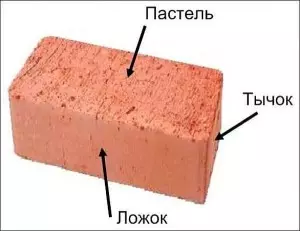
Brick faces name: pastel, spoons, stick
The biggest face is called " pastel ", Middle - Side -" Spoons ", And the smallest -" Pump«.
Brick dimensions, in principle, standardized (250 * 125 * 66 mm - single and 250 * 125 * 88 mm - one-time), but its production technology is such that they can differ significantly from different manufacturers: 2-3 mm in each of each The faces, and this is a rather significant difference, if you consider the number of pieces in one row. Therefore, before ordering a party, it is desirable to measure samples from several ruffs to determine how accurately the technology is withstanding.
It is also important to pay attention to the geometry: the faces should be located strictly at 90 °. Otherwise, driving loads will occur, and the wall may crumble.
Types of masonry
Brick walls can perform different roles. In some cases, it is only finishing, in some - partitions, and sometimes bearing walls. They proceed from the destination, as well as the required thermal conductivity of the walls, the type of brickwork is selected:
- In Polkirpich. Most often make facing. The thickness of such a wall is 125 mm. To save, you can put the material and on spoons, then it turns out the wall in a quarter of the brick. When the device of such (in 1/2 or 1/4), a reinforcing grid is stacked in each 4-5 row. It is necessary to increase the rigidity of the wall and create additional connections that increase the strength of the masonry.
- In brick. This may already be partitions or two bearing walls of small buildings. Wall thickness - 250 mm.
- In one and a half, two and two and a half bricks are already carrying walls.
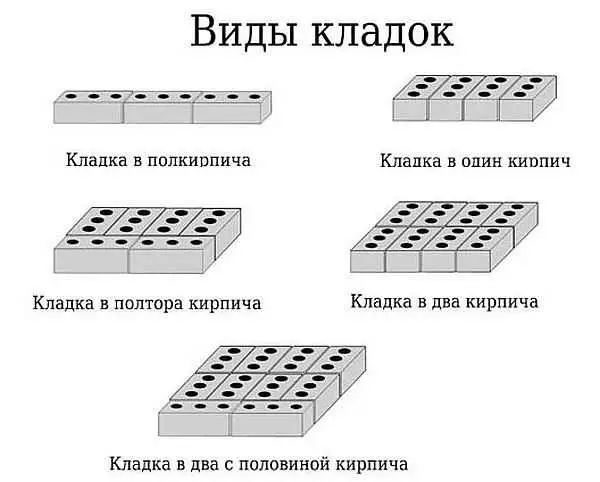
Types of brickwork: in Pollipich, in a brick, and a half and two bricks
Pulling and names of the series
Although the wall of the brick is composed of a variety of small elements, it should work as a monolith. To ensure increased strength, seams that are a weak place in this system, are made with a displacement. Specialists call this reception "dressing". He as if connects different elements into a single whole, allowing you to redistribute the load on large surfaces.
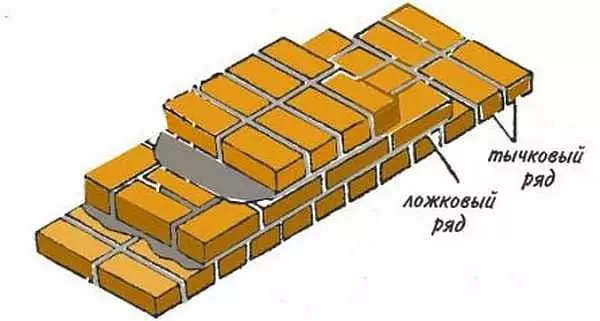
Spoon and twitch rows in brickwork
To ensure the necessary shutoff displacement, bricks are located in different ways:
- If they are turned to the front side of the smallest part - a tych, such a number is called Tychkov;
- If they are rotated with a long side - a spoon - a number called Naskovoy.
Moreover, the first in the masonry - on the foundation - there is a twitch, they finish the masonry. And for it, it is necessary to use solid bricks.
Single row bandage
Alternate alternation of such rows gives a very good result. Such a dressing method is called a single-row or chain dressing. It is practiced on the walls that are not planned to be finished: it looks neat. According to such a system, both outer and carrier walls can be folded.Wall masonry schemes
Examples of a single-row brick wall in 1.5 and 2 bricks are shown in the photo below.
Article on the topic: how to make a smoking
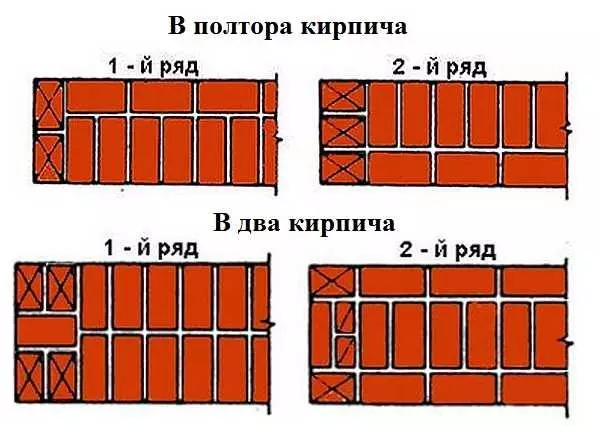
Single-row bandage in the wall of 1.5 and 2 croup
In the case of laying walls in two bricks, two more terms appear. Two outer spoonful series are called versts - Outdoor verst directed to the street Inner vest - to the room. For them, it is used even, good material, especially picking up those that are directed outside. Space between them is called Okunt . Since this element is closed from all sides, it is possible to use a lower grade material, for example, used.
Please note that with such a masonry, a sawdust brick is required: halves and three-solid. Three-fourth on the scheme crossed the cross on the cross, halves - one diagonal strip. How to make the adjoining partitions to the walls made in such a technique, shown in the photo below.
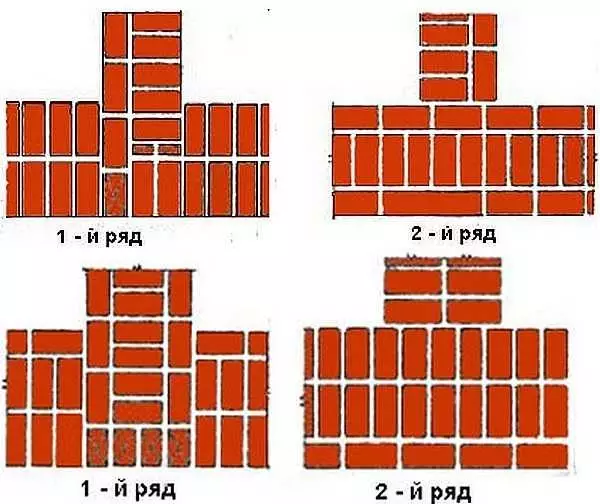
Wall adjoining with single-row dressing
Corner schemes
Masonry angle is very important in this case. According to the method, the corners are expelled at first, the cord is stretched between them, and then the wall laying is carried out according to the scheme. But the first to put angles, on how correctly they are expelled, they depend on how even the whole building will be. The laying circuit of the angle in 1 brick with a single-row dressing is located. The laying begins with the installation of two 3/4 pieces, then go integers.
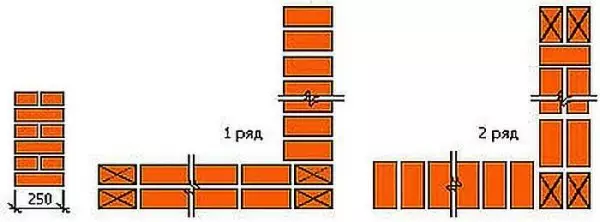
Angle in one brick with a single-row dressing
Sequence of actions Look in the video. A very detailed explanation with a step-by-step demonstration of the Procedure.
The same system, but in the wall of 1.5 bricks. Besides whole, slices are required 3/4 and quarters. A spoonful row alternately on the inner, then on the external verst.
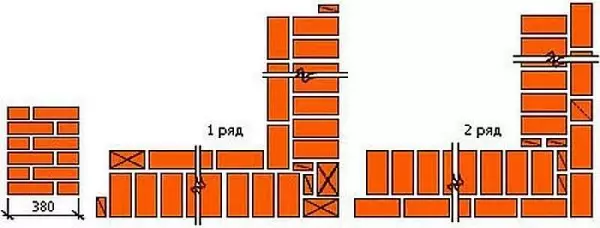
Scheme: angle in a half bricks with a single row dressing
As this scheme is placed in practice, look in the video.
When laying an angle of 2 bricks in the first row, all the same two three-fourth pieces are required, and another 6 fourth or, as they say checkers. In the second - one on 3/4 and two cups is already required.

Scheme: angle in two bricks with a single-row dressing
Multi-row bandage
With a multiple dressing, several spoon rows are 6 (for single bricks) or 5 (for one-time) - mixed with one pump. The first and the latter also put the chips. This method is also suitable for laying outdoor and inland walls. Only they are usually planned under insulation or finish.Wall masonry schemes
In order for such a system, separate columns, spoonful rows inside are also tied up. To ensure the displacement of the seams use crushed bricks.
Brickwork with your own hands: a multi-row dressing diagram of 2 and 2.5 bricks
The adjoining of walls with this method also occurs with the first. This ensures the increased strength of the adjoining of commoners. Schemes - in the photo below.
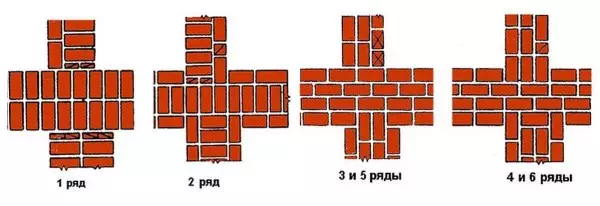
Laying patterns of adjacent walls
Masonry charts corners
And again about how to lay corners, but already with a multiple dressing. If the wall in one brick, even and odd rows (except the first) are the same.

The laying pattern of the angle of 1 brick with a multi-row dressing
All this you will see in the video.
If the wall is 1.5 bricks, in the first and second rows with tonchkovy, but located in the outer, then in the inner mile. The third and fourth rows are exclusively put on spoons.
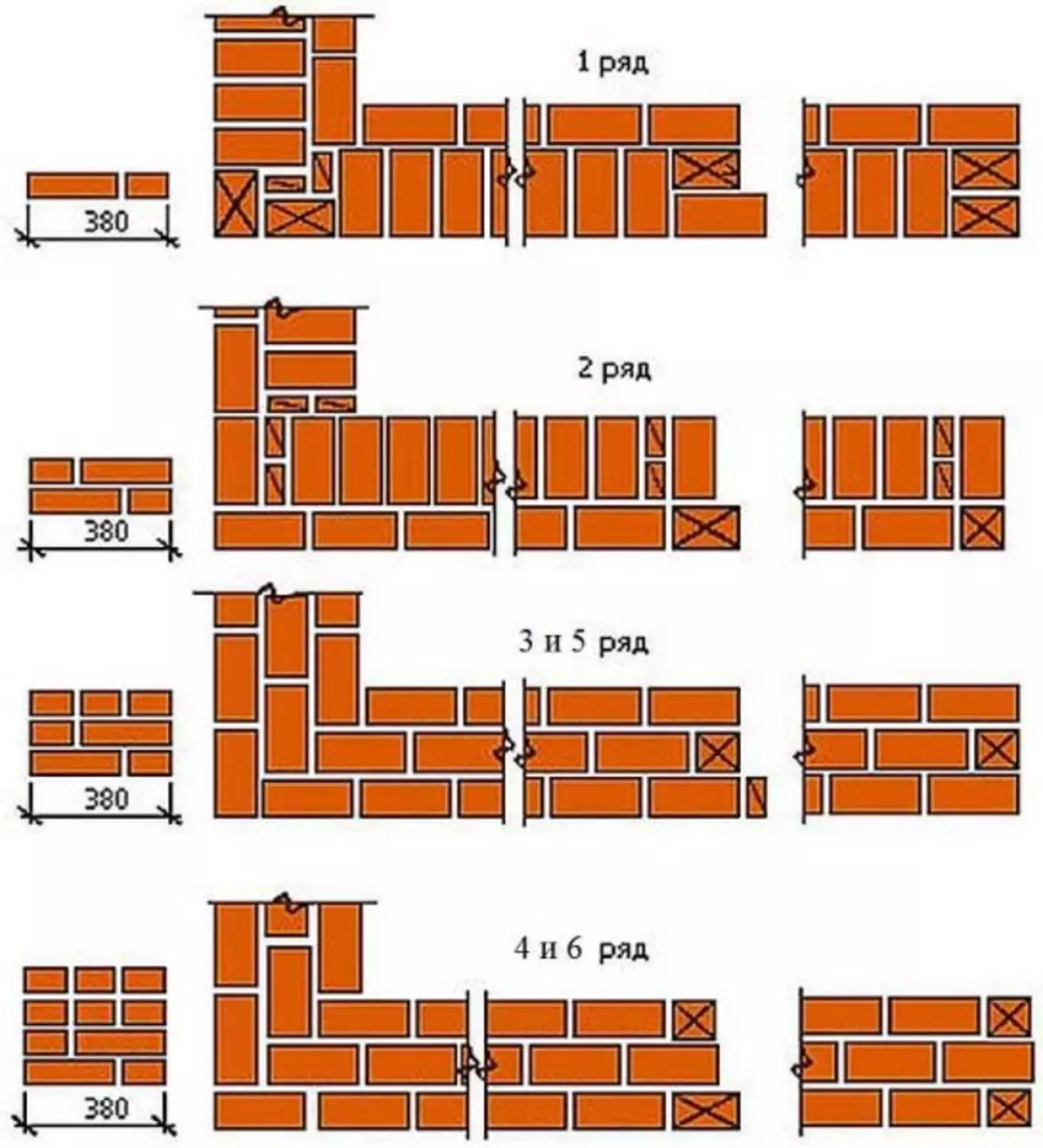
1.5 brickwork angle laying circuit with multi-row dressing
The fifth row is put similarly to the third, the sixth - the fourth. Next, the system is repeated. At times, not a multi-row (with 5 spoon poisons), and a three-row system. Then from the fifth row of Claus repeats.
Solution for brickwork
Brick is put on cement-sandy solution. Cement is not lower than M400, sand is clean, loose. The proportions for the specified brand - 1 to 4 (for M500 - 1: 5). They are making manually or with a concrete mixer, but the order does not change.
First, the sand is sifted, a binder is added to it, everything in a dry state is mixed until a homogeneous color is reached. Then plot water. Its quantity of 0.4-0.6 parts, but look at the plasticity of the solution. With a plastic solution, it is more convenient to work with a rigid, but when the hollow brick is laying in this case, the solution consumption is strongly increasing: it fills emptiness. In this case, it is more practical to make a hard solution.
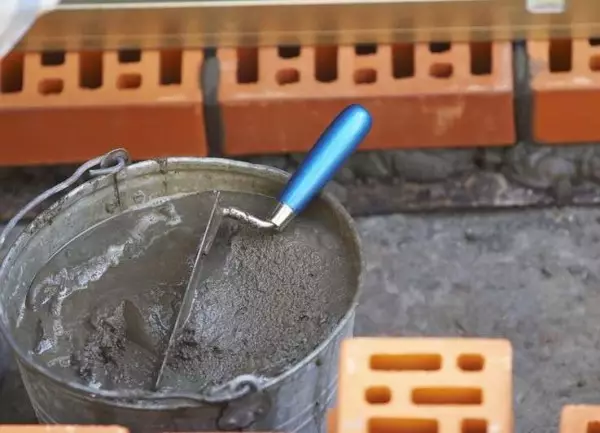
Masonry brickwork depends on the mortality consistency
To improve plasticity and more convenient operation, it is added to the composition of lime, clay or liquid detergent (you can have soap for hands, there are in large flasks). The number of additives is completely small - no more than 0.1 parts, but the characteristics of the solution are improved significantly: it is easier to lay it, it does not decrease longer.
Article on the topic: Silicone wall holders: how to join the sucker to the cafél, how to fix velcro and hooks for tile
Immediately it is worth warning: do not knead the large volumes at once. The cheapest must be used for two hours. And in the last half hours, it can be difficult to work with it: the separation of water can begin, and maybe begin to be captured. It depends on weather conditions and quality of cement, from the thoroughness of the kneading. If brick laying with your own hands is your first experience in this area, getting out will slowly. Therefore, it is better to make a portion of the solution small.
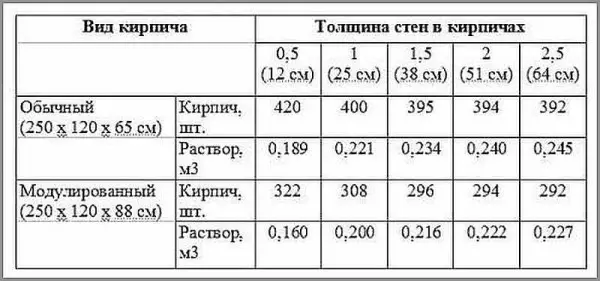
Approximate solution
Often, newcomers planning to lay a brick occurs: at what temperature you can work. Without special additives, it is possible to work with positive temperatures. In the best embodiment, not lower than + 7 ° C. This threshold at which the cement is normally seized. At lower temperatures, the hardening process almost stops, as a result, the solution can crumble, and the strength of the wall will be low. To reduce the bar there are special anti-corrosive additives, but the cost of such a solution is already high: the price of these additives is considerable.
Tech masonry bricks
Before use, the solution is stirred, since heavy particles can fall down, and water climb up. The mixed solution is applied to the bucket and transfer to the placement location, where it is distributed. Immediately put the strip of solution - bed - for one row. Under the twitching series width bed 200-220 mm, for a spoonful - 80-100 mm. If the seam is filled in completely, about 10-15 mm are retreating from the edge, the solution height is 20-25 mm, which, when laying, provides seams of 10-12 mm. Before installing the brick, the solution is aligned with cells.There are three techniques for brickwork. On the hard low-plate solution use the technique "Let's". At the same time, the seams are filled completely. If the layer is plastic, use the technique of "principle".
Brickwork technique "Injection"
As already spoke, this method of masonry bricks is used with a plastic solution. It should be movable, easy to apply and shifted. This is achieved by adding additives. It is possible to lay out the solution immediately to the entire surface of the wall: additives allow you to extend the time before the setting.
The bed holds a thickness of about 20 mm, the order of about 15-20 mm remains from the edge. Such an indent avoids the squeezing of the solution to the front surface, but at the same time the edges of the seams remain frequently empty. This significantly reduces the strength of the wall, because in the regions with seismic activity, the laying of the vest rows (outer and internal) is prohibited by such a method.
When laying a spoonful row taking a brick, holding it with a slight tilt. Summing up to the already laid, at a distance of 8-10 cm begin to raise the solution to the edge (tych). When docking it turns out that the seam is already partially filled. Brick is attached a bit down (hesitated), pressing it to bed. Surplus are removed by Kielma and depart or in a bucket, or on the wall.
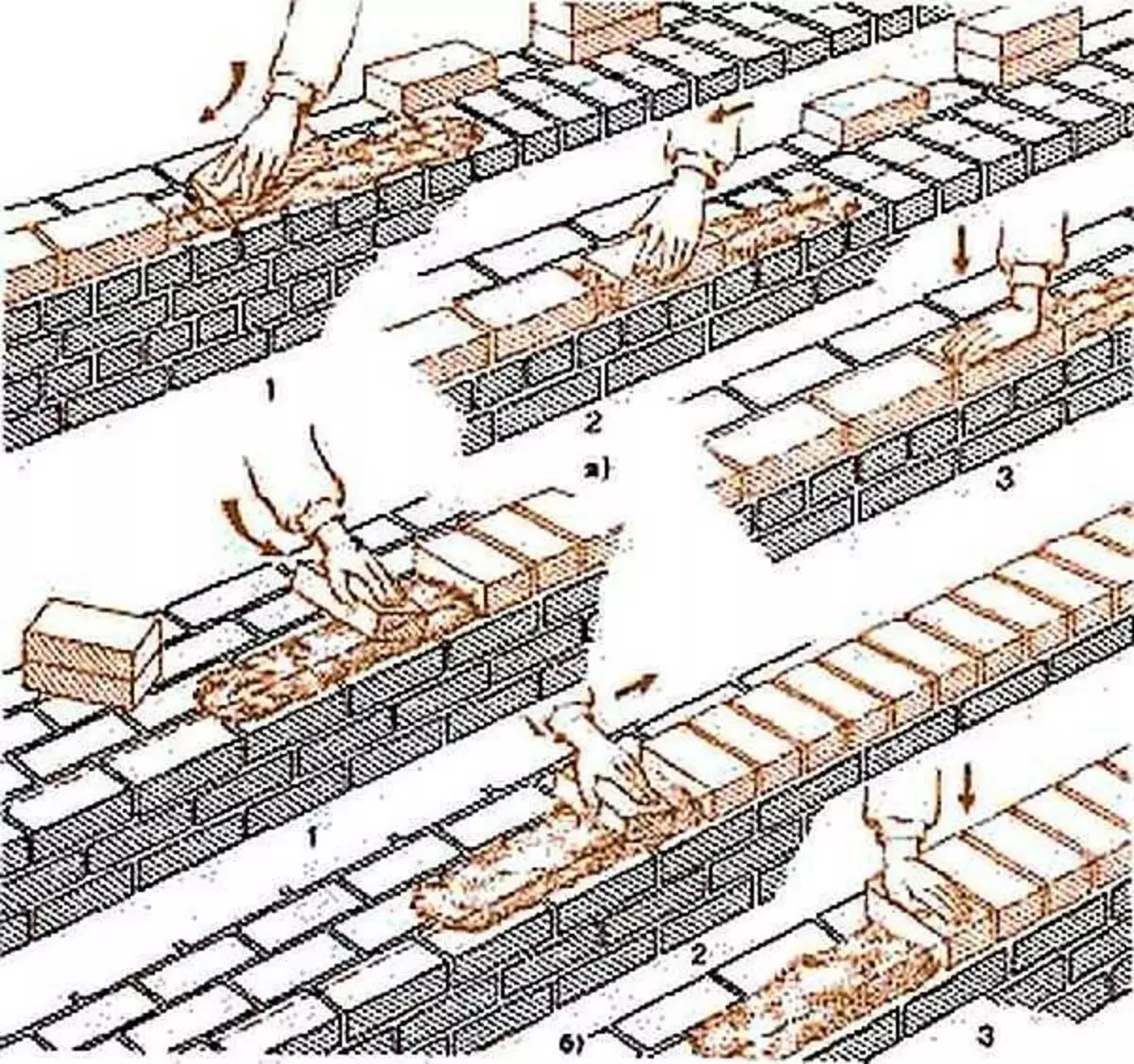
Masonry Masonry Brick "Rizetik"
With this technique often it turns out that the vertical seams are filled only partially. Because this method is called another "empty". They are filled when laying beds for the next row. If the technique has not yet been very worked out, filling the seams better before laying the following row: emptiness reduce the strength and thermal insulation characteristics.
When laying a toncho series, everything is also just, only we will prigify the solution with a spoofing face. The slaughterhouse is stacked, like the tile rows, and then pressed the palm. It is necessary to monitor all the stones on the same level. It is done with the help of a construction level, and the verticality of the wall checks the plumb every 3-4 rows.
Technique "Let's"
When working with hollow bricks, rigid solutions are usually used. In this case, it is used by the brick technique "Let's". In this case, it is also necessary to work.
The bed is placed at a distance of 10 mm from the edge, the thickness is still about 20 mm. Since the same composition stretches badly, it is prevented by the edge of the laid brick tool. Left hand take a brick and press it to Kelma, at the same time pulling it up. In this case, continue to put the brick, seeking the required thickness of the seam (10-12 mm).
Article on the topic: Pump for forced sewage (with chopper and without) - Sololift and other models
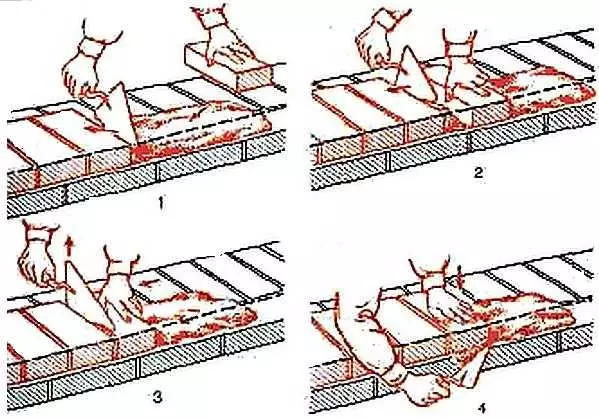
Technique "Instruptyk"
Surplus the solution is selected by Clavma. Setting several fragments, taking the level checking the horizontal of the row, tapping the knob of the Kelma straightening the position. The solution squeezed at that time. It turns out a dense laying, but the process takes longer: more movements are required.
Direction with trimming
The average productivity method is to use the sutures of the seams. At the same time, the Bed method is folded close to the edge (10 mm), as when the masonry is taking, and the masonry method is in addition: zipped the solution with brick, put, put it, removed the excess. If the wall is subsequently not planned to be separated by anything, after several rows it is necessary to take the extender - a special tool and give the seams the required form (convex, concave, flat).As you can see, this is a kind of symbiosis. To work it was more convenient, the solution is also made with the "intermediate" plasticity. If it is too liquid, it will flush along the wall, leaving the drums, because it needs to be kneaded slightly more densely than when laying in addition.
Brickwork DIY: Tools, order and features
Now, how to lay a brick with your own hands you have an idea, you need to talk about the procedure for actions as well as some technical nuances.
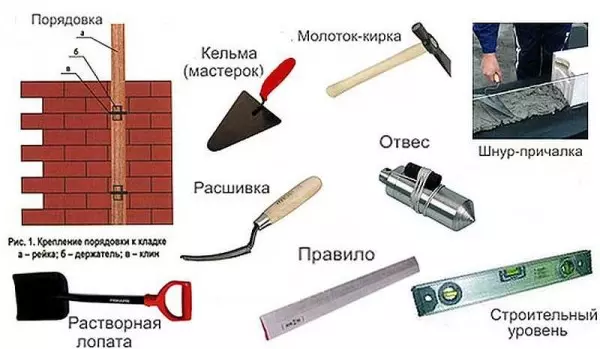
Sample brickwork tool list
Let's start with the tool. We will be needed:
- Mason Kelma - apply and spitting on bricks;
- concrete mixer or tank for the kneading solution;
- mortar shovel - for kneading and periodic mixing;
- two to three buckets for the solution;
- pinch - check vertical walls and angles,
- Construction level - to check the horizontal masonry of the row;
- Poison cord - to beat the ranks;
- Box (for shape molding);
- Molotok-Kirk for the belling of defective bricks (halves, 3/4 and cupcakes - 1/4);
- Rule is a metal or wooden smooth plank for checking the wall plane.
Read more about the features of technology. First: Before use, brick is preferably soak. Especially important is in hot dry weather. Then it will be less "pull" moisture from the solution. If the moisture is not enough, cement will not be able to gain the required strength, which will affect the strength of the building.
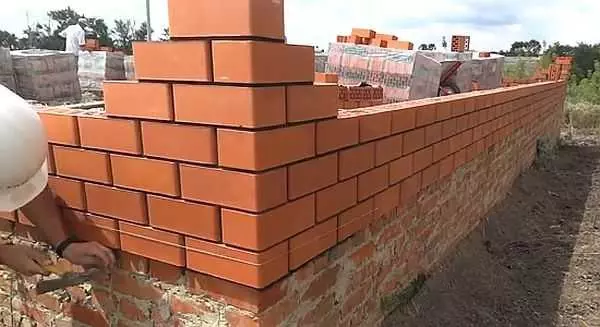
First, two corners are expelled, then they are associated with several rows of brickwork.
Second: the first corners are driven out. First two first. They are binding to 2-3 rows of bricks on the selected laying scheme. Then the third angle is driven out. The second and third are also associated with several full-fledged rows. After the fourth angle and the perimeter closes. So it should be erected by the walls, bypassing them around the perimeter, rather than cast the walls in turn. This is one of the most common mistakes.
Third: There are two solid control technologies. The first - nails are inserted into the seams of the corners, which are tied with laces. It needs to be tightened so that he noted the top face of the brick, and also limited the outer (and if necessary) the surface of the wall.
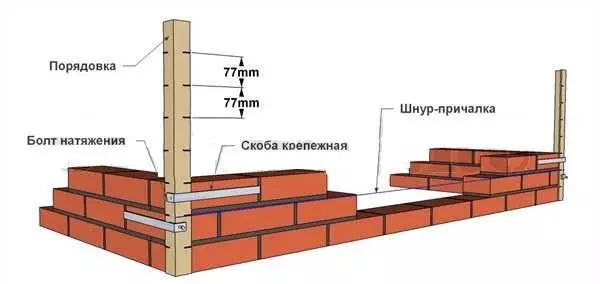
Fit coach fastening cord
The second method is to use wooden or metal spitches. This is a flat strap or corner, on which letters are applied every 77 mm - risks on a tree or cutting on metal. They note the required thickness of the row: the height of the brick + seam. They are installed with the help of flat mounting brackets, which are inserted into the seam. If necessary, they are then simply removed and rearranged above.
There is another way - a corner of a mason. It has on the one hand a slot in which the whar is started. "Sits" by an angle per solution.

Rubbing with a corner of a mason
The disadvantage of this method is the same as simply nailing in the seam: the height of the row should be monitored by "manually" when the corners are removed. With a lack of experience (and where to take it, if the brickwork is done with their own hands for the first time) it is difficult. Having (making it yourself), the order is all easier.
Fourth: Preparation of defective bricks. As you saw, halves, three-fourth bricks and cupcakes are used when laying - 1/4 of part. In order for the work does not slow down, you need to prepare them before laying. This is done with the help of a hammer-kirk. When preparing, high accuracy is required, otherwise a bandage will be bought. To control the length easier, it makes markers of the corresponding length on the handle. Having attached a handle to the brick, it makes marks on both sides of the spoon. Then, by putting Kirk's blade to the mark, they beat the hammer on the reverse side, making scubons. Having grabbing on both spoons, a strong blow of the kirk is cleaned with a brick.
